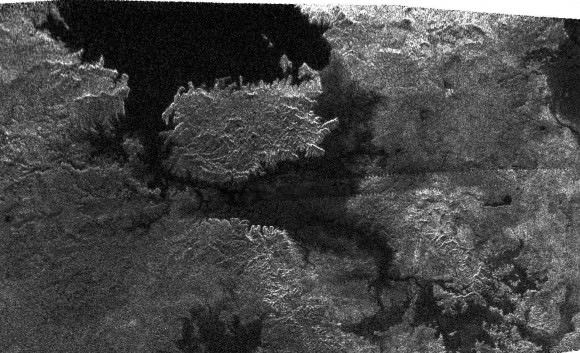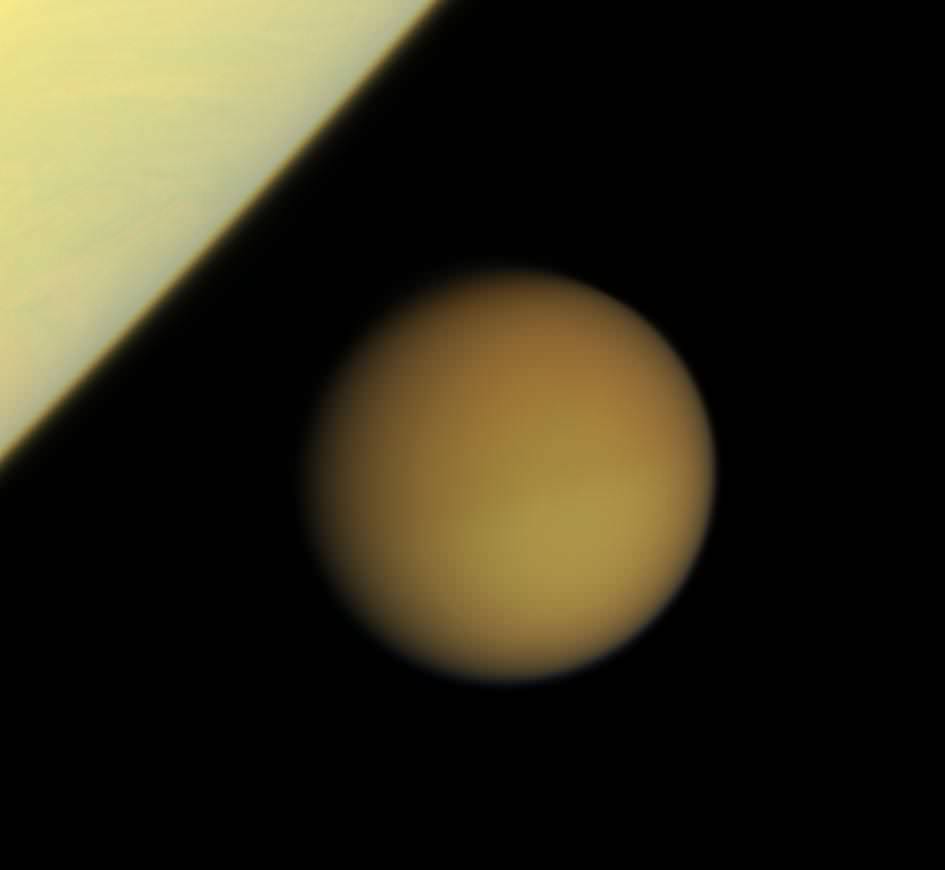[/caption]
Think Titan looks pretty round?
Not quite, according to new data released today by the Cassini radar team — and slight irregularities in the shape of the bizarre moon may account for the concentration of lakes at the highest latitudes, among other perplexing features.

The radar image above, obtained by Cassini’s radar instrument during a near-polar flyby in 2007, shows a big island smack in the middle of one of the larger lakes imaged on Saturn’s moon Titan. The island is about 90 kilometers (62 miles) by 150 kilometers (93 miles) across, about the size of Kodiak Island in Alaska or the Big Island of Hawaii. The image is centered at about 79 north degrees north (north is left) and 310 degrees west, adding weight to the theory that most of Titan’s lakes occur near the poles.
Titan is an intriguing object partly because its climate cycles are reminiscent of Earth’s, but tend to rely on hydrocarbons like methane and ethane instead of water — which couldn’t exist in a liquid state at temperatures hundreds of degrees below zero. Methane and ethane fill the air with a smoggy haze that rains down as ash. Sometimes it’s washed away by hydrocarbons that flow like gasoline and collect in black lakes with surfaces as smooth as glass.
Cassini has been orbiting Saturn for four years, observing Titan periodically with multiple radar instruments. A research team led by Howard Zebker, a geophysicist at Stanford University, has been using the radar data to estimate the surface elevation. Combined, two instruments — a nadir-pointing radar altimeter and a multiple-beam synthetic aperture radar (SAR) imaging system — measure the time delay of the altimeter echoes and the precise radar beam angles to points on the surface.
“These techniques show that the poles of Titan lie at lower elevations than the equator, and that the topography also varies longitudinally,” the authors report in today’s Science Express..
“If we posit that the lakes are surface expressions of a more or less continuous liquid organic ‘water table,’ then the lower elevations of the poles could lead to the observed preponderance of lakes at high latitudes,” they add. In other words, the lower elevations of poles may make them the only places where any continuous, liquid “water table” would be close enough to the moon’s surface to appear as lakes.
Titan’s overall shape, they suggest, might be that a sphere slightly flattened at the top and bottom. The exact mechanisms behind the oblate shape are unclear. Titan is also elongated toward Saturn, due to the tides raised by Saturn’s gravity.
Source: The paper appears online at the Science Express website. More Titan images are available at the Cassini website.


I’m not buying the idea about the ring material accumulating onto Titan’s equatorial regions. I think this grossly overestimates the amount of material that may have been in the rings over the forseeable past. Furthermore, Titan orbits Saturn outside all of the rings.
Furthermore, Titan orbits Saturn outside all of the rings.
Maybe it sucked up all the ring material out there?
“The exact mechanisms behind the oblate shape are unclear.”
Could Titan spinning on its axis have anything to do with it?
Catsceo- I am no way an expert on this, and did not research google about rotation period, I assume almost any low density large spinning moon or planet will have a oblate shape whether tiny or much like Saturn. I hope an expert will clarify this interesting feed.
More lakes at the poles makes sense – if its internal heat is being kept up by its rotation and Saturn’s tidal forces then the equator will be warmer and then possibly less likely to be cool enough for methane lakes, possibly.
Titan has tidally locked rotation, so one revolution takes 15days 22 hours. That is low enough to not expect much flattening due to rotation.
One intriguing possibility would be that Titan has accumulated considerable ring-material over the millenia, and that this material has ‘landed’ more on the equatorial regions and less on the polar regions. Large local differences gets evened out relatively quickly, small global differences (high equator low polar) can remain for along time.
“One intriguing possibility would be that Titan has accumulated considerable ring-material over the millenia, and that this material has ‘landed’ more on the equatorial regions and less on the polar regions. Large local differences gets evened out relatively quickly, small global differences (high equator low polar) can remain for along time.”
Good idea! ? ? ? ? ? ?
“One intriguing possibility would be that Titan has accumulated considerable ring-material over the millenia, and that this material has ‘landed’ more on the equatorial regions and less on the polar regions. Large local differences gets evened out relatively quickly, small global differences (high equator low polar) can remain for along time.”
Good idea! ? ? ? ? ? ?
“One intriguing possibility would be that Titan has accumulated considerable ring-material over the millenia, and that this material has ‘landed’ more on the equatorial regions and less on the polar regions. Large local differences gets evened out relatively quickly, small global differences (high equator low polar) can remain for along time.”
Good idea!
Titan’s orbit is slightly inclined to the plane of Saturn’s rings. This greatly decreases the opportunity for Titan to grab some stray material from the ring system.
It could also be the opposite, the poles beeing warmer and has more liquid loses more material in space.
Incredible that we’re getting such good images of a Saturnian moon.
“Titan’s orbit is slightly inclined to the plane of Saturn’s rings. This greatly decreases the opportunity for Titan to grab some stray material from the ring system”
I dont mean for Titan to gather any of the current ring system, i was concidering the possibility it used up pretty much all of a prehistoric part of the rings that are now long gone. The moon Iapetus have possibly done something similar, causing a equatorial ridge that are very obvious on close images.
But I am speculating, yes.
I’m not buying the extratitanian material idea either, but for another reason.
Remember Huygens? It was made of metal, and yet it needed a heat shield to cross safely the dense titanian atmosphere. What do you think would happen to any infalling ring material, which is basically chunks of ice?
Yup: It would completely evaporate long before it got even in sight of the surface. So no, I don’t think that idea is viable as an explanation.
Catsceo,
Titan’s rotation period is 16 days, which is quite slow and unlikely to make Titan very oblate. Also, rotation would cause the “water table” itself to be oblate, making the “water table” likely to be at the same depth at the poles as at the equator.
@Excalibur, I can see where you’re coming from. After all Titan’s orbit could have at one time been aligned with the plane of Saturn’s rings, perhaps being affected by a later impact to alter its’ orbital inclination. A long term dynamical evaluation of Tittan’s orbit in the distant past to far in the future may be able to elucidate this question.
Maybe Titan acquired a centrifugal equatorial bulge a long time ago when it was spinning much faster and not yet tidally locked to Saturn.
That Saturn has raised the elevation on Titan’s facing side after locking makes me ponder geological questions on the moon’s composition and thixotropicity thereof. All that ‘oil’ slushing around might go very deep. Great! we can power any lander with a big inch V8 😉
`It doesn’t matter. I’m not planning on moving there.
IDK, our space shuttles need heat shields yet frozen hail makes it to Earth’s surface. I’m not really sure that frozen water not being able to make it to Titan’s surface is a given.
Hail doesn’t travel at orbital velocities.
Saturn’s gravity may have something to do with it.
“Think Titan looks pretty round?”
Titan’s radius is 0.6 km smaller at the poles than at the equator according to the abstract of this article’s source paper. For an equatorial radius of 2574.9 km that is a difference of just 0.02%. Compare this with Earth’s 0.3% or Saturn’s 10% difference. Titan does appear quite round indeed.
Information on the Earth and Saturn was taken from Wikipedia.
Good work!